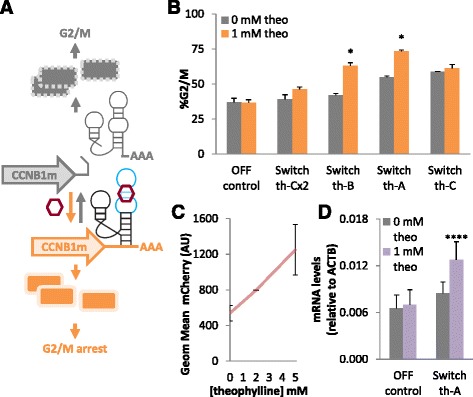Fig. 3.

Small molecule-responsive ribozyme switches control arrest of cells in G2/M. a Schematic of the mechanism by which ribozyme switches mediate small molecule-dependent transition of cells into a G2/M arrest state, rather than the normal G2/M state, by regulating expression of CCNB1m. b A set of theophylline-responsive switches and a non-switch control (wild-type sTRSV hammerhead ribozyme; OFF control) were inserted in the 3′ UTR of CCNB1m, stably integrated into U2-OS T-Rex Flp-In cells, and tested with 0 or 1 mM theophylline (theo) for their ability to arrest cells in G2/M. c Characterization of gene-regulatory activity of switch th-A measured as reporter protein activity as a function of theophylline concentration. HEK293 cells were transiently transfected with a plasmid encoding switch th-A in the 3′ UTR of a mCherry reporter and induced with varying levels of theophylline. Mean fluorescence of the population was measured by flow cytometry. d Characterization of gene-regulatory activity of switch th-A measured as CCNB1m transcript levels in the presence and absence of theophylline. Cell lines harboring the stably integrated OFF control and switch th-A in the 3’UTR of the CCNB1m expression cassette were grown in 0 or 1 mM theophylline and CCNB1m transcript levels relative to that of a housekeeping gene (ACTB) were measured by qRT-PCR. *, p < 0.05, ****, p < 1E-4. Error bars represent standard deviation across biological triplicates for (b) and duplicates for (c) and (d)
